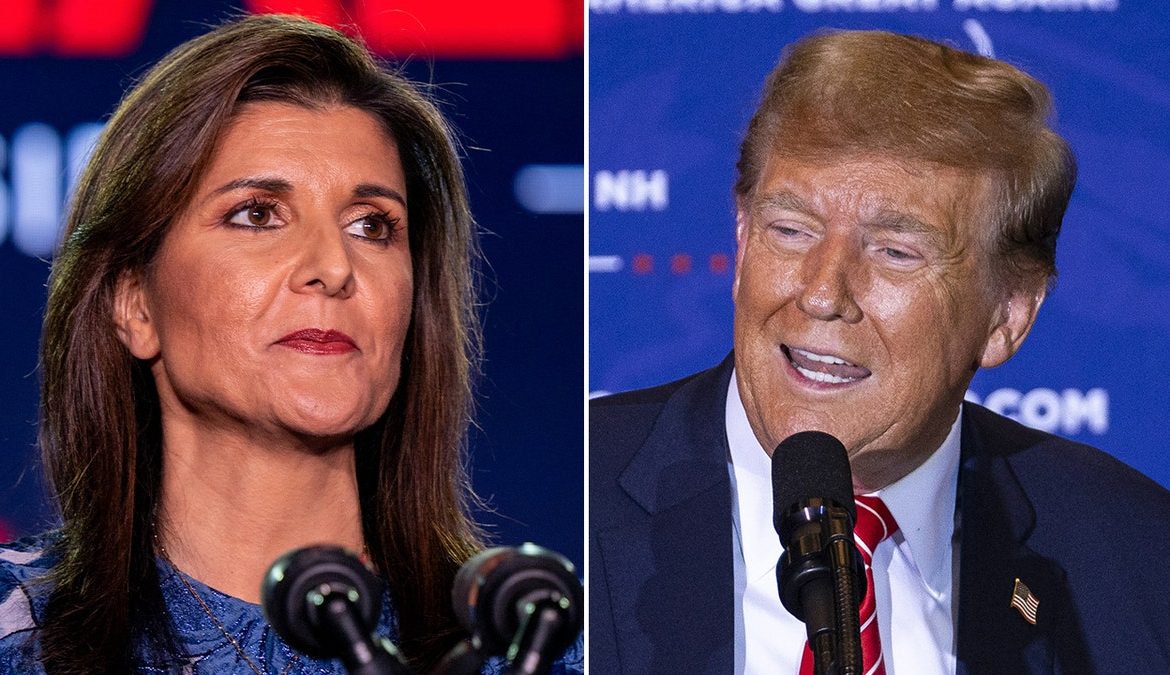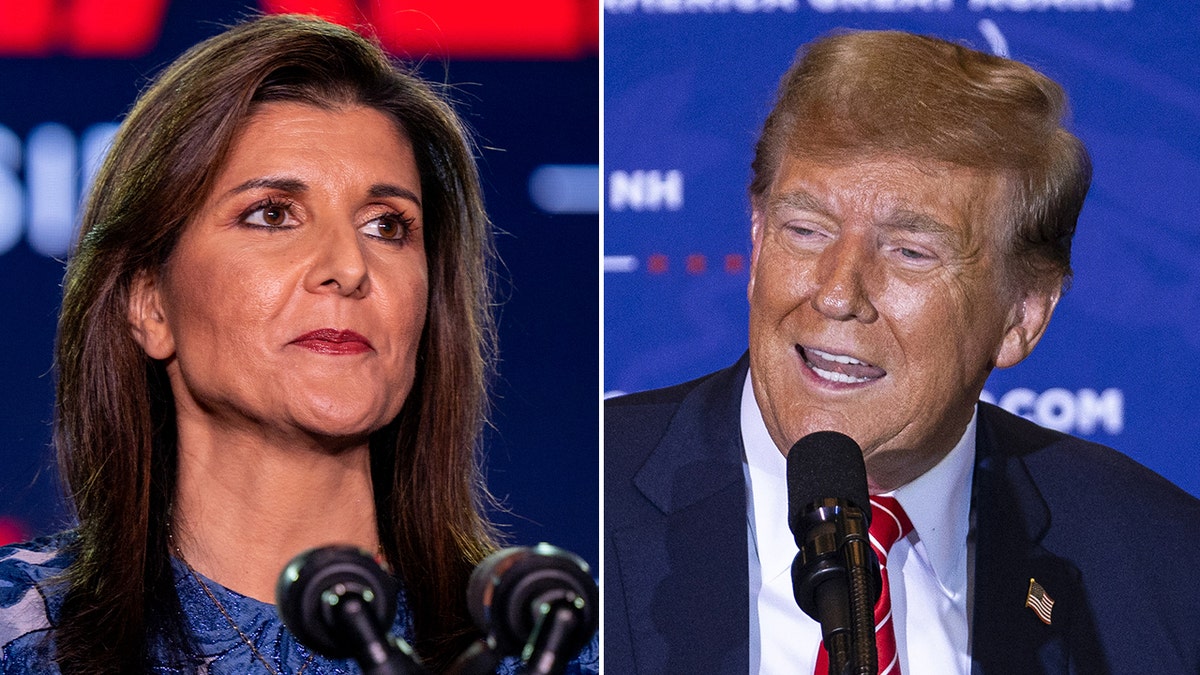
When could Trump become the GOP nominee? Here’s what the numbers tell us

Donald Trump continues to dominate in the Republican primary.
The former president notched support from an average of 75% of national GOP voters in polls released by NBC News, CNN and Quinnipiac University over the last four weeks.
His opponent, Nikki Haley, received support from an average of 20% of Republican voters in the same polls.
Still, this race isn’t over until a candidate wins 1,215 or more delegates.
Haley reminded voters this week that she is ‘not going anywhere,’ pledging to stay in until at least Super Tuesday. It could be longer.
The former South Carolina governor faces an extremely steep climb to make this race competitive. She would need a much-stronger-than-expected showing in her home state this weekend and then use the momentum to win several more states between now and late March.
That’s because late March is likely the earliest time when Trump could clinch the majority of delegates and, therefore, become the presumptive nominee.
The state of play
Trump currently has 63 delegates, Haley has 17.
That’s after the former president’s wins in Iowa, New Hampshire, Nevada and the Virgin Islands – the four primaries or caucuses that have taken place so far.
While Haley has not won a contest, the former governor put up a fight in New Hampshire and won nearly as many delegates in Iowa.
Both those states allocate delegates proportionally, meaning that the number of delegates a candidate receives aligns with their relative vote share.
The road to Super Tuesday
There are several contests before Super Tuesday with a total of 185 delegates on the line:
- South Carolina, Feb. 24: There are 50 delegates at stake this Saturday night. The statewide winner will take all of the 29 at-large delegates available. The winner in each congressional district receives another three delegates per district won (up to 21 delegates). Haley has campaigned heavily in her home state, making this the next major contest to watch. Special coverage begins at 7 p.m. ET on Fox News Channel.
- Michigan, Feb. 27 and March 2: 16 delegates are on the line in Michigan’s primary, part one of a two-part nominating contest there. They will be awarded to the candidates proportionally (if they get 12.5%+ of the vote). On March 2, another 39 delegates will be awarded at district conventions.
- Idaho, March 2: 32 delegates are at stake, and the candidate with a majority of the statewide vote will take all of them.
- Missouri, March 2: Missouri is holding precinct caucuses on March 2, but delegates won’t be awarded until later in the process.
- D.C., March 1-3: There are 19 delegates on the line in the nation’s capital; the candidate who wins the majority will take them all.
- North Dakota, March 4: The day before Super Tuesday, 29 more delegates will be awarded. If a candidate gets 60% of the vote, they win all of those delegates; otherwise, delegates will be awarded proportionally to candidates with at least 20% of the vote.
Super Tuesday
Super Tuesday gets its name from the large number of states – and, therefore, the large number of delegates – on offer in one night. The total is 874.
Here are those states and a summary of the key rules (in many cases, this is not an exhaustive list of all the rules for each state). The total possible delegates for each category of delegates are listed in brackets.
- Alabama: 50 delegates. Statewide (29): majority-take-all, otherwise proportional for candidates with 20%+ of the vote. Congressional districts (21): majority-take-all or winner-take-most.
- Alaska: 29 delegates, proportional (13%+).
- American Samoa: 9 delegates nominated by a delegate resolution.
- Arkansas: 40 delegates. Statewide (28): majority-take-most or proportional (15%+). Congressional districts (12): majority-take-all or winner-take-most.
- California: 169 delegates, majority-take-all or proportional.
- Colorado: 37 delegates, proportional (20%+).
- Maine: 20 delegates, majority-take-all or proportional (20%+).
- Massachusetts: 40 delegates, majority-take-all or proportional.
- Minnesota: 39 delegates. Statewide (15): 80%-take-all or proportional (20%+). Congressional districts (24): proportional (20%+). A candidate who receives 80%+ statewide wins all congressional district delegates as well.
- North Carolina: 74 delegates. Statewide (32): proportional (20%+). Congressional districts (42): ⅔-take-all or winner-take-most.
- Oklahoma: 43 delegates. Statewide (28): majority-take-all or proportional (15%+). Congressional districts (15): majority-take-all or proportional (15%+).
- Tennessee: 58 delegates. Statewide (31): ⅔-take-all or proportional (20%+). Congressional districts (27): ⅔-take-all or winner-take-most.
- Texas: 161 delegates. Statewide (48): proportional (20%+). Congressional districts (114): majority-take-all or proportional (20%+).
- Utah: 40 delegates. Majority-take-all or proportional (15%+).
- Vermont: 17 delegates. Majority-take-all or proportional (20%+).
- Virginia: 48 delegates. Statewide (12): majority-take-all or proportional (15%+). Congressional districts (33): majority-take-all or proportional (15%+).
Most of the Super Tuesday states have majority-take-all rules. In a race with two major candidates left, this means the candidate who wins is very likely to take all of those delegates.
If Trump won every single delegate on offer between today and Super Tuesday, which is highly unlikely if Haley remains in the race, he would take a total of 1,122 delegates. That is still about a hundred delegates short of the 1,215 needed to win.
Later in March
There are two more ‘mini Super Tuesday’ events as March rolls on, along with other contests. In summary:
- Wyoming, ending March 10: 12 delegates through county conventions.
Then it’s on to Super Tuesday II on March 12 with 161 delegates total:
- Georgia: 59 delegates. Statewide (17): proportional (20%+). Congressional districts (42): majority-take-all or winner-take-most.
- Hawaii: 19 delegates. Statewide (13): proportional. Congressional districts (6): proportional.
- Mississippi: 40 delegates. Statewide (28): majority-take-all or proportional (20%). Congressional districts (12): winner-take-most. A candidate who receives a majority statewide wins all congressional district delegates as well.
- Washington: 43 delegates. Statewide (13): majority-take-all or proportional (20%+). Congressional districts (30): majority-take-all or proportional (20%+).
These states have a mix of delegate rules that make it difficult for one candidate in a competitive race to win them all.
If Trump were to sweep the March 12 contests, he would become the presumptive nominee with a total of 1,295 delegates by the end of March 12.
March 12 is the earliest possible date of a Trump victory
A win on March 12 is very unlikely, though, given that Haley has made investments in several upcoming states.
It’s more likely to take until at least March 19, when several more states with large delegate hauls have their primaries.
The total number of delegates awarded ticks up again starting March 15:
- Northern Marianas, March 15: 9 delegates, winner-take-all.
- Guam, March 16: 9 unbound delegates (so we’ll exclude these for now).
Then comes Super Tuesday III, on March 19, with 350 total delegates in one night:
- Arizona: 43 delegates, winner-take-all.
- Florida: 125 delegates, winner-take-all.
- Illinois: 64 delegates. Statewide (13): winner-take-all. Congressional districts (51): delegate election.
- Kansas: 39 delegates, winner-take-all.
- Ohio: 79 delegates, winner-take-all.
If Trump remains the leader of this race, then it is possible that he could win all 350 delegates on this night. That would hypothetically give him as many as 1,654 delegates by this point of the race.
March 19 is a possible Trump victory date
There is only one more contest in late March:
- Louisiana, March 23: 47 delegates, winner-take-all.
If Haley is much more competitive by this point in the race, then Trump would have to wait until at least April 2 to reach 1,215 delegates.
And of course, in that scenario, Haley would have amassed a significant number of delegates of her own, making it possible for her to become the presumptive nominee late in the primary season.
If the race continues into April, it will become competitive
There are still many delegates on the table in April. In summary:
- April 2: Connecticut, Delaware, New York, Rhode Island, and Wisconsin. 195 delegates total.
- April 6: Missouri (district conventions). 40 delegates.
- Ending April 20: Wyoming (state convention). 17 delegates.
- April 21: Puerto Rico. 23 delegates.
- April 23: Pennsylvania. 67 delegates, but only 16 are bound delegates.
These are all possible dates for Trump or Haley to prevail. The remaining states are split between May and June:
- May 4: Missouri (state convention). 11 bound delegates, 3 unbound delegates.
- May 7: Indiana. 58 delegates.
- May 14: Maryland, Nebraska, and West Virginia. 105 delegates.
- May 21: Kentucky and Oregon. 77 delegates.
- June 4: Montana, New Jersey, New Mexico, and South Dakota. 63 bound delegates, 31 unbound delegates.
No matter what, we will have a presumptive winner before June 5.
